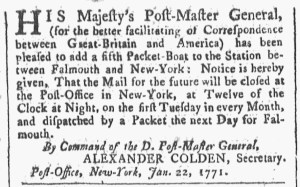What was advertised in a colonial American newspaper 250 years ago today?

“A RIDER between Philadelphia and that place.”
William Stenson played a part in establishing and maintaining the communication infrastructure that connected Baltimore and Philadelphia and points in between in the mid 1770s. Though it had not displaced Annapolis, Baltimore became an increasingly significant urban port on the eve of the American Revolution. In August 1773, William Goddard launched the Maryland Journal, the city’s first newspaper. At about the same time, Joseph Rathell attempted to establish a subscription library, but could not manage to generate sufficient interest to compete with William Aikman’s circulating library in Annapolis. For a small fee, Aikman delivered books to subscribers in Baltimore.
Still, Baltimore was becoming an increasingly important commercial center, a place of interest for merchants and others in Philadelphia. That created an opportunity for Stenson. On February 23, 1774, he informed readers of the Pennsylvania Journal that he was “employed by a number of Gentlemen in Baltimore, &c. as a RIDER between Philadelphia and that place” and offered his services during his weekly transit. He left Philadelphia “early every Thursday morning” and arrived in Baltimore “on Friday evening.” He stayed until Monday morning and returned to Philadelphia “on Tuesday evenings.”
Stenson attempted to hire his services by the year, suggesting how regularly he believed some prospective clients in Philadelphia wished to contact correspondents in Baltimore and towns on the way. He offered a “yearly subscription,” pledging that “whatever affairs may be committed to the care of the subscriber, will be performed with all possible fidelity and dispatch.” For those not ready to pay for his services for an entire year, the rider promised that they “may have their business done at reasonable rates.” Clients could contact him or leave orders “at Mr. WILLIAM GRAHAM’s, at the sign of the Black Horse” on Market Street. Alternately, a “subscription paper now lies at the London Coffee-House,” a popular gathering place for Philadelphia’s merchants to conduct business. Stenson aimed to make procuring his services as convenient as possible for his prospective clients.


